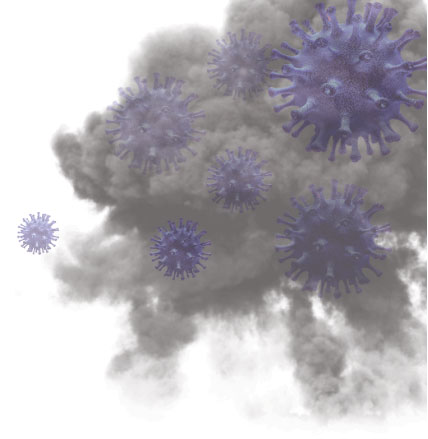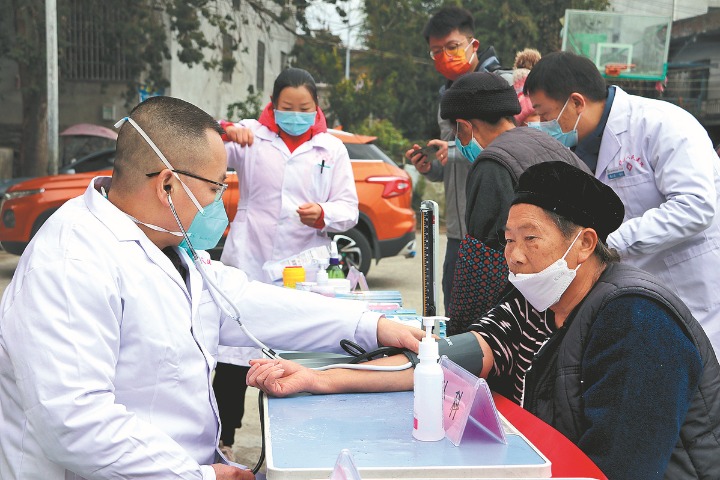Does air pollution weaken defense against COVID-19?

Two Hong Kong scientists say they agree with global studies that the city's polluted air is likely to increase susceptibility to COVID-19.
Leung Chi-chiu, chairman of the Hong Kong Medical Association Advisory Committee on Communicable Diseases, suspects the city's choking pollution attacks the body's immune system, opening the door to a host of potential ailments — including infection from the novel coronavirus.
He notes that scientists are still studying the character of the virus, but before the case is proved with some degree of certainty, people should take extra precautions. He cites air pollution and secondhand smoke as a couple of irritants that damage the airways of the lungs.
Leung said that on days when pollution is severe, more children come down with the flu or other respiratory infections than they will on other days in Hong Kong. He adds, however, that COVID-19 is far more deadly than seasonal flu.
A correlation between levels of air pollution and COVID-19 came to light from studies in northern Italy, an area with a high level of air pollution that was hit hard in the global pandemic.
The findings were revealed in a joint research paper published last month by scientists from Italy and Denmark, who put the question in perspective.
The paper cited data from Italian Civil Protection for March 21. On that date, COVID-19 lethality in Lombardy and Emilia Romagna — two northern Italian cities — reached around 12 percent, which was about two times higher than it was in the rest of Italy. The 12 percent was also much higher than what authorities recorded in other parts of the world. Meanwhile, the Hubei provincial capital of Wuhan, the original epicenter of the virus, recorded a death rate of 7.7 percent at the earliest stages of the global outbreak before scientists had time to study it.
The Air Quality Index adopted by the European Environment Agency analyzed data collected from more than 2,000 air quality monitoring stations across Europe and found that northern Italy is one of the most polluted areas in the world. This is due to its climate and geographic conditions that prevent air pollution from dispersing soon enough.
Policies for controlling the pandemic are the same throughout Italy. The healthcare system is the same. The population is similar across the state. Thus, the researchers concluded that the polluted air, which was a major distinguishing factor in the north, played a significant role in the region's high lethality.
The researchers support this conclusion by pointing out that air pollution is already known to impair the body's first line of defense — the upper airways. The upper airways are more likely to be attacked by high-level pollutants and are "more prone to chronic respiratory conditions". Thus, the airways are more easy to fall prey to pathogens, the paper said.
The paper cited a list of pollutants suspected of undermining the body's immune system: PM2.5, PM10, near-ground ozone, nitrogen dioxide, and sulfur dioxide.
The researchers identified a possible link between respiratory damage from long-term exposure to air pollution and susceptibility to new maladies that appear. Early death from chronic, acute respiratory distress can occur from long-term exposure to toxic air. Patients with underlying respiratory and cardiovascular issues are especially vulnerable.
The findings of a study by the Harvard T.H. Chan School of Public Health came to a similar conclusion. The study revealed that an increase of 1 microgram per cubic meter in PM2.5 correlated with an 8 percent increase in the COVID-19 death rate. The study finding was based on scrutiny of COVID-19 death records of over 3,000 counties in the US.
"A small increase in long-term exposure to PM2.5 leads to a large increase in the COVID-19 death rate," the study said in its conclusion, adding that it will be important to continue to control air quality during and after the current pandemic.
There is no known cure to COVID-19, and most patients survive from the disease because they have a strong immune system.
"There is no silver bullet for coronavirus pneumonia," said Zhou Huili, head nurse at the Hong Kong-funded Wuhan Asia General Hospital. She was in charge of 17 COVID-19 patients in ICU wards.
Zhou, who saw 10 patients die on her watch, said there was not much medical workers could do in the ICU. "All we could do is help them to survive in the most difficult two to three weeks and help them develop antibodies," Zhou said.
Atmospheric researcher Amos Tai Pui-kuen, associate professor at the Earth System Science Program of the Chinese University of Hong Kong, believes that air pollution has exacerbated the pandemic.
"Air pollutants, such as particulate matters or aerosols, can carry and spread pathogens," Tai said.
In the case of COVID-19, it could be transmitted through droplets from people sneezing and coughing, or even just talking to someone close by.
"Bad air in northern Italy is believed to facilitate the spread of the novel coronavirus among the population with already weakened immune and health conditions," Tai said.
But it is hard to ascertain to what degree the air pollutant has played a role in Hong Kong's epidemic situation, Tai said.
Unlike the situation in northern Italy, it's hard to consolidate the air pollution's role in the city's epidemic development, as every city has different epidemic containment measures that would bring significant differences in epidemic situation locally, Tai said.
People who have contracted COVID-19, especially those who required intensive care, suffer damage to their lungs from the inflammation. Some are at risk of developing pulmonary fibrosis, making them more vulnerable to the toxic air, Leung said.
Most people who recover from the virus will carry on with their daily lives as normal. But athletes and people who do physical labor are likely to experience lasting effects, he added.
Leung predicts that COVID-19 will stay on throughout the year until a vaccine is developed.
"There is a high chance that it will be an endemic that would continue to exist among us and cause a small-scale outbreak," Leung said.
So is the long-lasting air pollution. In 2019, Hong Kong recorded its highest level of ozone pollution for the past 21 years, according to the government's latest figures. The Hong Kong Environmental Protection Department said the rising trend will not stop, at least not before 2025. A high concentration of ground-level ozone is believed to inflame and damage the human respiratory system and has been linked to premature death from respiratory causes, according to the website of the United States Environmental Protection Agency.
Nevertheless, we should be prepared to face more polluted air, coupled with a lurking endemic that might resurge until we have a vaccine.
Please feel free to contact us by sending your questions to question@chinadaily.com.cn or commenting on China Daily app. We will ask experts to answer them.














